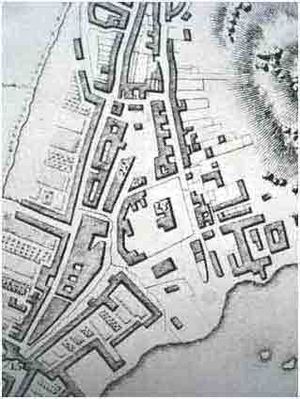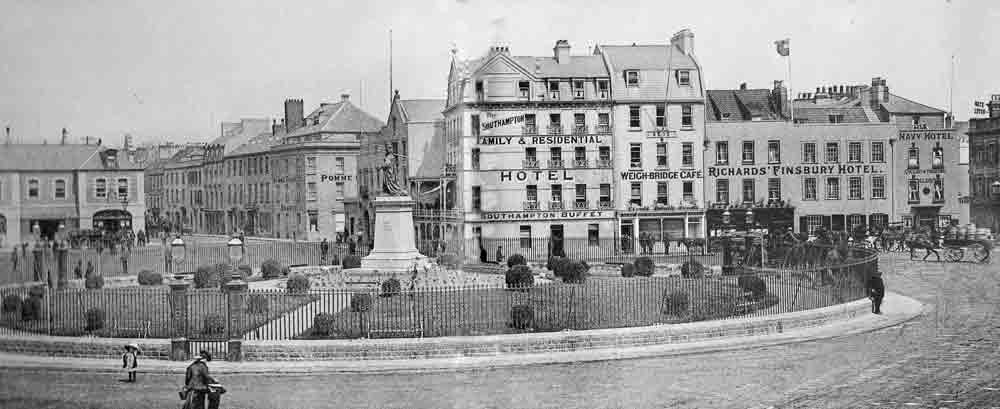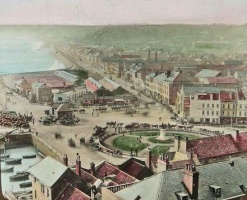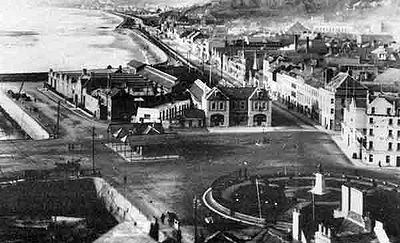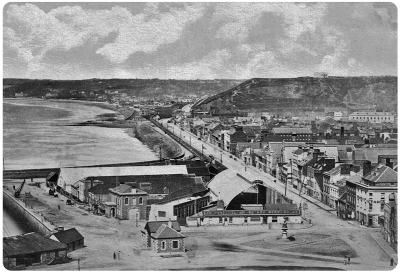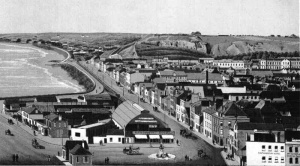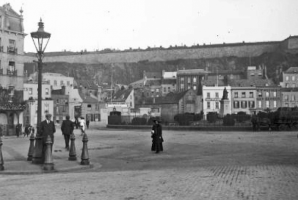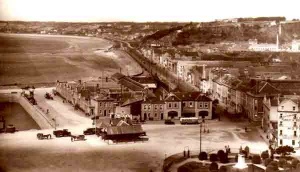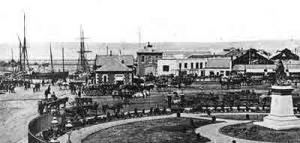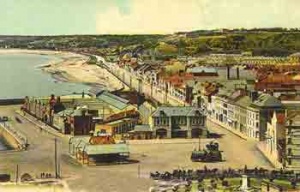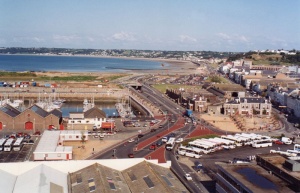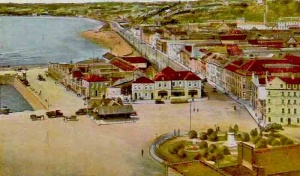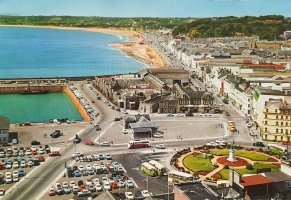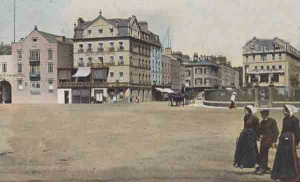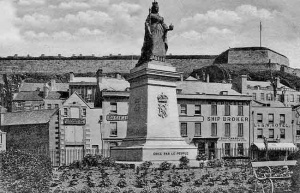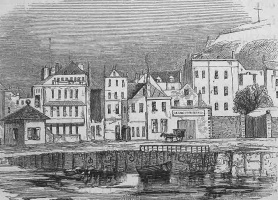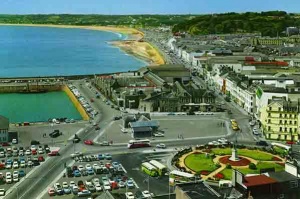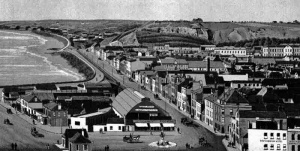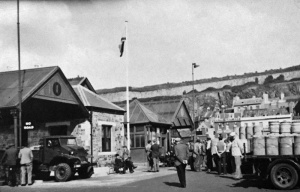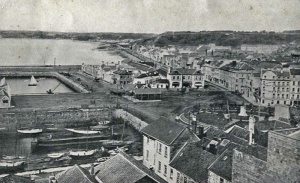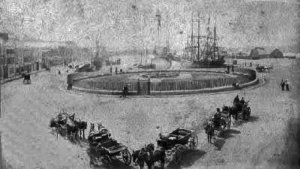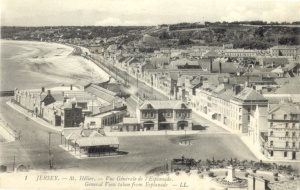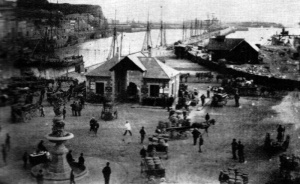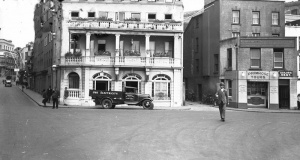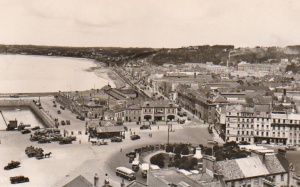On the coast
|
|
The Weighbridge
An early map of St Helier before the land on which the Weighbridge stood had been reclaimed The Weighbridge is one of the most important locations in St Helier. The name has been taken by the whole area to the north of the Old Harbour and New North Quay, where the original public weighbridge formerly stood
|
This is all reclaimed land, the shoreline of St Helier having previously been over 200 metres to the north on the south wall of the town churchyard. Gradually, from the 18th century onwards, the sea was pushed back, as first warehouses, and then hotels and other properties, were built to the south of the church.
Then construction of St Helier Harbour began in the 19th century, and gradually more and more land was reclaimed - a process which is continuing to this day.
The weighbridge itself was ordered to be constructed in 1825, and, as the island's potato industry developed, for several weeks of every year it was the centre of island life, as farmers brought their crop to St Helier for weighing, packing and then shipping out of the island.
In 1870 the town terminus of the Jersey Western Railway was built; in 1877 a new weighbridge was built in front of the terminus, closer to the harbour and the original building was demolished; in the late 1880s a circular garden was laid out, initially with a tall flagpole in the centre, before it was replaced with a statue of Queen Victoria, which was unveiled in 1890.
The Weighbridge's darkest days were in June 1940, when thousands of islanders queued there awaiting evacuation, and it was later the scene of an aerial attack by German forces, which would shortly occupy the island, after ordering white crosses of surrender to be painted on the Weighbridge and Royal Square.
Five years later, when the island was liberated, the Weighbridge was the scene of great jubilation, as crowds flooded the area to see the Union Flag unfurled on the balcony of the Pomme d'Or Hotel which stands on the edge of the Weighbridge open area.
Today a memorial square with freedom statue has been constructed on this side of the Weigbridge, but the opposite side, in front of the Jersey Museum, where the statue used to stand, and leading towards Commercial Buildings is an open area awaiting redevelopment as a public arena. The statue was moved closer to the old railway terminus, then the tourism centre, in 1970 and its surrounding gardens demolished, to allow the bus station which was then located there to be enlarged. The weighbridge itself also disappeared in 1970. In 1976 the statue was moved to the Triangle Park at West Park.
At first the Old Harbour stretched much further towards the Royal Yacht Hotel but a section was filled in during 1884 to allow the circular garden to be constructed. At this point there was only a narrow stretch of land between the harbour and the garden. In 1928 more of the harbour was filled in to create land for car parking.
Other articles
- The 'island site', the history of the abattoirs and other buildings on the site adjoining the Weighbridge
- Pictorial chronology of the Weighbridge, viewed from Fort Regent

Dated photographs

Click on an image below to see larger picture
New weighbridge in 1877 Photographed by Ernest Baudoux. The single central weighing bridge would eventually be joined by two more at either side of the building
A picture by Ernest Baudoux from the early 1880s
1883 Picture by Ernest Baudoux
Dates confusion
The dates attributed to pictures of the reclaimed land on which the Weighbridge garden was located can be very misleading. Three of those below were part of a sequence taken by Ernest Baudoux, presumably at the same time as the larger image further up the page. They show the area of land reclaimed from the harbour, the top wall of which was moved several metres down to create the space where the statue of Queen Victoria would be erected in 1890. One of the images is dated 1884, another 1886, and the third, 1890, but they certainly appear to have been taken within a short time of each other, and the date of 1887 attributed to the larger picture above seems most likely. The dates for all pictures taken of this area in the 1880-90s must be seen as approximate, but a definitive date of 28 July 1889 for one of them cannot be accurate because the circular garden is known to have been laid out in 1888, with a flagpole at its centre until the statue was unveiled in 1890

A picture by Albert Smith taken before 1900
In 1900, when this picture was taken by Albert Smith, the Old Harbour can be seen reaching to within feet of the new Weighbridge Gardens
The view from the Star Hotel on the corner of Mulcaster Street in the early 1900s
A horse and van photographed by Edwin Dale in 1904
1905?
These pictures illustrate the difficulty encountered in trying to date photographs taken more than 100 years ago. They were all received dated 'circa 1905'. That date might be accurate for the pictures on the left and below, but the one on the right was taken much earlier, long before the frontage of the railway terminus had been replaced by the granite building which subsequently became the island's Tourism office, and still stands today. An investigation of the dates of various pictures of the Weighbridge elsewhere in this website put a date of 1879 on the centre picture
A 1906 photograph by Albert Smith
A picture of the Weighbridge in 1907 by Philip Morel-Laurens
The Weighbridge viewed from the bottom of Conway Street in the early 1930s
The statue of Queen Victoria moved from its original position in the centre of the circular gardens to a temporary location in front of the Tourism offices in the former railway terminus, before another move to West Park
Potato exports
An earlier photograph attributed to Edwin Dale showing farmer's vans laden with potatoes waiting to use the weighbridge. He cannot have been the photographer, because it has to have been taken before 1877 and he was not born until 1882
Sundry photographs not yet dated
Click on an image below to see larger picture
Looking down on the Weighbridge from Fort Regent. The land in the left foreground was created by infilling the top of the Old Harbour
Weighbridge Gardens with the statue of Queen Victoria, and warehouses on the New North Quay (now the Maritime Museum and Occupation Tapestry Gallery) in the background
Militiamen at the Weighbridge, opposite the junction of the Esplanade and Conway Street
An Ernest Baudoux photograph including the Southampton and Royal Yacht Hotels and shipbroker W T Pugsley
Picture of the weighbridge by Albert Smith
Picture of the weighbridge by Albert Smith
Picture by Ernest Baudoux
Picture by Ernest Baudoux
The drag hunt used to meet at the Weighbridge, as shown in this Albert Smith photograph
An Ernest Baudoux photograph showing Shaw's Navy, Adderson's Star and Royal Yacht Hotels and the new sailors' home
Picture by Ernest Baudoux
Picture by Ernest Baudoux
Sailing vessels pack both sides of the New North Quay for this Ernest Baudoux photograph
A picture by Edwin Dale of a family group in the Weighbridge Gardens
Picture of the gardens by Albert Smith
Picture by Albert Smith
Albert Smith picture
Photograph by Ernest Baudoux
Photograph by Ernest Baudoux
Photograph by Ernest Baudoux
Photograph by Ernest Baudoux
Photograph by Ernest Baudoux
Photograph by Ernest Baudoux

Photograph by Philip Godfray

